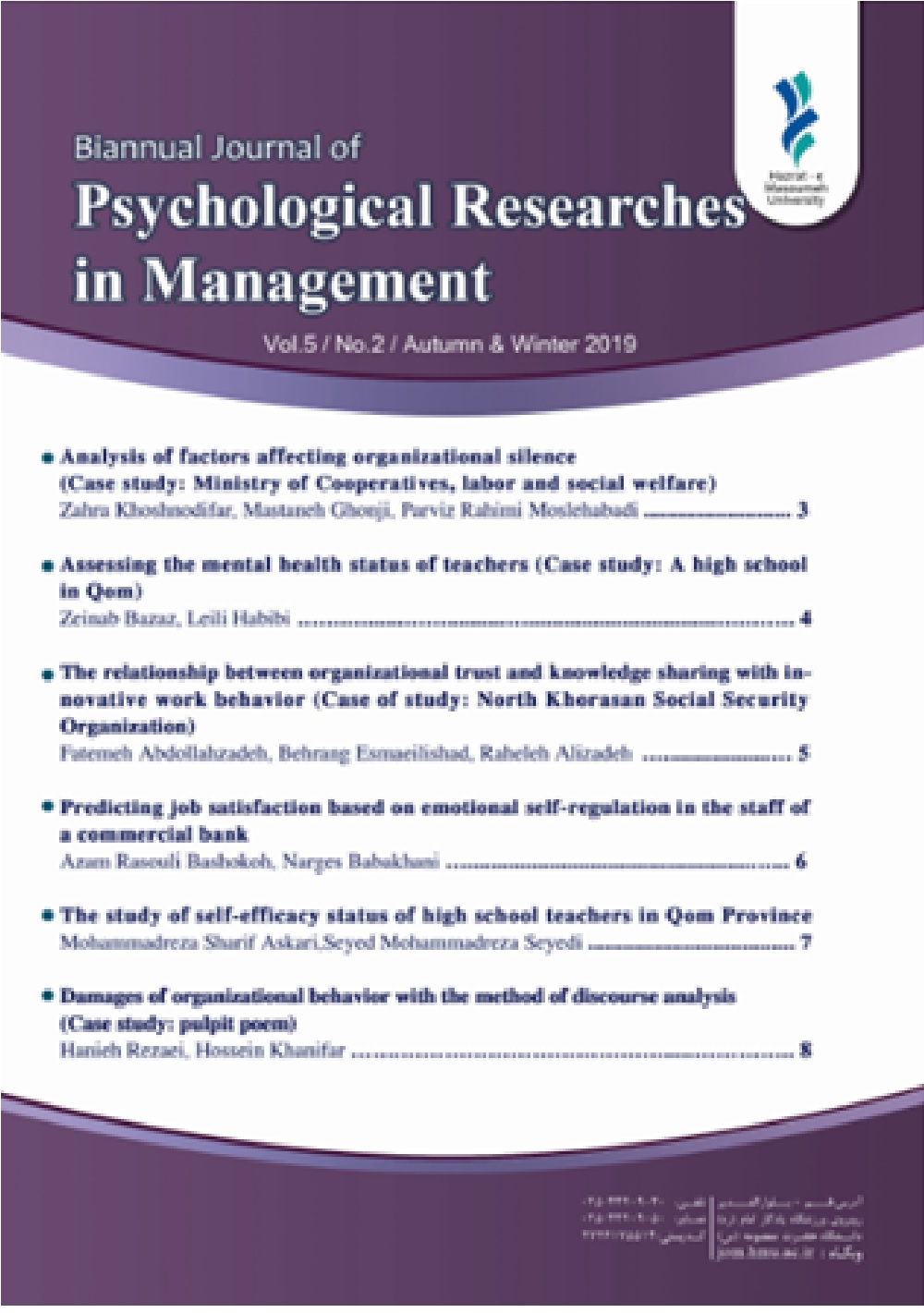Document Type : Original Article
Authors
1 MSc. of Business Management, Naser khosrow Institute of Higer Education, Saveh, Iran
2 PhD in Public Sector Policy, Tarbiat Modares University, Tehran, Iran
Abstract
In general, the survival and development of any society depends on the efficiency and quality of education in that society. Every country needs motivated and efficient teachers as one of the pillars of education to be able to educate its youth. Develop its education system and prepare it for a better future. This study was conducted to investigate the self-efficacy status among high school teachers in Qom province. In this way, by recognizing the status of self-efficacy, steps can be taken to improve the level of teachers' functions. In this study, a questionnaire was used to assess the level of self-efficacy. The reliability and validity of the questionnaire were assessed through content validity and Cronbach's alpha calculation. The statistical population was high school teachers in Qom province that 328 people were selected as a sample based on Morgan table and random sampling method. The sample was analyzed and the results showed that the level of self-efficacy of teachers is at an appropriate level.
Keywords
- 1. پورعباد حماملو، عادل (1384). وضعیت سلامت روانی دانش آموزان و ارتباط آن با خودکار آمدی و پیشرفت تحصیلی. http://tabriz3edu.blogfa.com/post-24.aspx.
- تقی پور ظهیر، علی (1376). مبانی و اصول آموزشوپرورش. تهران: انتشارات آگاه.
- حسینی نسب، داوود؛ احمدیان، فاطمه و روانبخش، محمدحسین (1384). بررسی رابطه شیوههای فرزندپروری با خودکارآمدی و سلامت روانی دانش آموزان. مطالعات تربیتی و روانشناسی دانشگاه فردوسی. 21-38.
- سلمانی دستجرد، ابراهیم؛ همتینژاد، مهرعلی و رحمانی نیا، فرهاد (1387). رابطه آموزشهای ضمن خدمت با خود کارآمدی معلمان تربیتبدنی. نشریه حرکت، شماره ۳۷، 193-204.
- کریم زاده شیرازی، ماندانا؛ رضویه، اصغر و کاوه، محمد حسین (1387). ارتباط کیفیت زندگی و خودکارآمدی معلمان شاغل شهرستان شهرکرد. مجله دانشگاه علوم پزشکی شهرکرد. دوره 10، شماره 1، 35-28.
- Appelbaum, steven H., Hongger, Karen. (1998)."Empowerment: a contrasting overview of organizations in general and nursing in parti- cular –an examination of organizational factors, managerial behaviors, job design, and structural power". Joural of Empowerment in organization. Vol.6, No. 2, pp.29-50.
- Bandura , A. (1982). Self-efficacy mechanism in human agency, American Psychologist , Vol. 37, pp. 122–147.
- Bandura A. (1994). Self-efficacy. In: Ramachaudran VS. Encyclopedia of human behavior.NewYork: Academic Press, pp.71-81.
- Bandura A. (2000). Cultivate self-efficacy for personal and organizational effectiveness. In: Locke.
- Bandura, A. (1997). Self-efficacy: the exercise of control. New York: W. H .Freeman.
- Best, R., Leavey, G., Rothì, M. D. (2008). On the front-line: Teachers as active observers of pupils’ mental health Teaching and Teacher Education, Vol. 24, No. July 2008, pp. 1217-1231.
- Chen, P. P. (2003). Exploring the accuracy and predictability of the self-efficacybeliefs of seventh-grade mathematics students, learning and Individual Differences, Vol. 14, pp. 79–92.
- Dougherty, C. M. Johnston, S. K. Thompson, Elaine Adams. (2007). Reliability and Validity of the Self-Efficacy Expectations and Outcome Expectations after Implantable Cardioverter Defibrillator Implantation Scales, Applied Nursing Research, Vol. 20, pp. 116–124.
- EA. Handbook of principles of organization behavior. UK: Blackwell, Oxford, pp: 120-136.
- Gibbs, C.J. (1997). “Teacher thinking, teaching thinking, and selfefficacy”.
- Gibbs, S. & Dembo, M.H. (1984). “Teacher efficacy: A constract validation”. Journal of Educational psychology, 76, PP: 569-582.
- Hadjistavropoulos, H. Dash, H. Hadjistavropoulos, T. Sullivan, Terri-Lynn. (2006).Recurrent pain among university students: Contributions of self-efficacy and perfectionism to the pain experience, Personality and Individual Differences, Vol. 42, pp. 1081–1091.
- ILO. (2000). mental health in the workplace: situation analysis (preliminary report). Geneva: US ILO.
- Lev, S. Koslowsky, M.(2009).Moderating the collective and self-efficacy relationship, Journal of Educational Administration,Vol. 47 No. 4, pp. 452-462
- McMullen MB. (1999). Characteristics of teachers who talk the DAP talk and walk the DAP walk. J Res Childhood Educ, 13(2), pp. 216-230.
- Muris, P. (2002). Relationships between Self – efficacy and symptoms of anexiety disorders and depression in a normal adolecent sample. Personality and Individual Differences 32. pp 337-348.
- Pekkanli Egel, I. (2009). the prospective English language teacher’s reflections of self, Procedia Social and Behavioral Sciences, vol.1, pp.1561–1567.
- Schwarzer R. Perceived self-efficacy of teacher’s questionnaire. Avalaible from: bttp://www.ralfsch warzer.do.
- Steven, M. Bakker, A.,Van Dijk, D. G. Mathieu H. G, Lemmink, K.A. P. M Rispens, P.(2001). A Dutch Translation of Questionnaire Assessing Self- Efficacy in leisure- Time, Journal of Aging & Physical Activity, Vol. 9, pp. 223- 232.
- Stipek. D, Weize. J. (1998). Perceived personal control & academic achievement, Review of Educational Research, VOL.52, pp.101-137.
- Veijola, J. Jokelainen, J. Laksy, K. Kantojarvi, L. Kokkonen, Jarvelin, M.R. (2002). The Hopkins symptom checklist–25 in screening DSM-III-R Axis–I Disorder. Nord J. Psychiatry. Well-being (PP.27-47), Oxford: Pergamon.
- Whetten, David.A & Cameron, Kim s. (1998). Developing anagement skills. New York: Addison – Wesley, Wheelan.
- Whetten, David.A & Cameron, Kim s. (1998). Developing Management skills. New York: Addison – Wesley, Wheelan.
- Wood, R. Bandura, A. (1989). Social cognitive theory of organizational management, Academy of Management Review, Vol. 14 No.3, pp.361-384.
